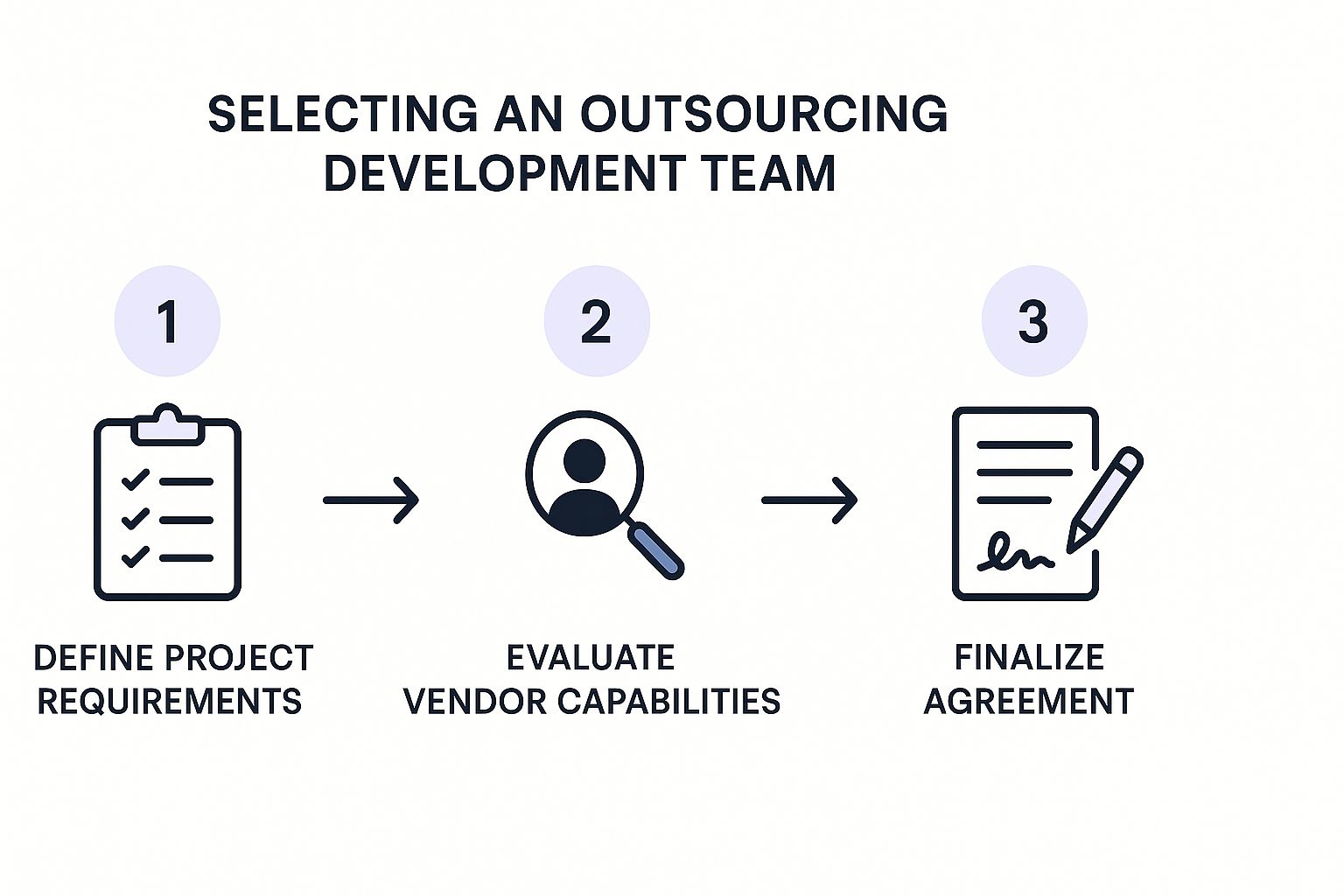
When you hear “outsourced development team,” your mind might jump straight to cost-cutting. While that’s part of the picture, it's an outdated view. Today, it’s about a strategic partnership—hiring an external, specialized group of software pros to drive your projects forward.
For a growing number of businesses, this isn't just a tactical move; it’s the secret sauce for staying competitive and agile. It's how you access top-tier skills, launch products faster, and scale your tech muscle without the usual growing pains.
Let's get past the obvious. The decision to bring in an outsourced development team is rarely just about the budget anymore. For today's top companies, it's a core strategy for building a serious competitive edge.
This approach lets you sidestep the frustrating local talent shortages and tap into a global reservoir of specialized expertise. Think AI wizards in Latin America or cybersecurity gurus in Eastern Europe—talent that would be incredibly difficult, if not impossible, to find and hire locally.
Speed and agility are everything in the modern business world. An outsourced team can be assembled, vetted, and ready to go in a fraction of the time it takes to recruit, hire, and train an in-house one. This acceleration means your product hits the market sooner, starts generating revenue, and captures market share while your competitors are still sifting through resumes.
While the opportunity to reduce operational costs is a major draw, the real genius lies in converting fixed payroll into a flexible operational expense. This shift is a game-changer for scaling. You can instantly ramp up your team for a big product launch and then scale back down just as easily, all without the logistical and emotional headaches of layoffs.
This strategic flexibility is exactly why the industry is booming. The global software outsourcing market is on track to hit a staggering $591 billion by 2025, with a solid 64% of IT leaders already outsourcing development. These numbers aren't a fluke; they prove that outsourcing is now a mainstream strategy for serious growth and innovation.
The biggest shift I’ve seen is companies moving from outsourcing to cut corners to outsourcing to build better. It's about bringing in world-class talent and processes that force your own product development to level up.
At the end of the day, partnering with an outsourced development team is about building a more resilient, efficient, and innovative company. It’s a deliberate choice to let your internal team focus on your core business, while entrusting the technical heavy lifting to dedicated experts who live and breathe great software.
Deciding between building your own team and outsourcing can feel daunting. Each path has its own set of trade-offs, and the right choice depends entirely on your company's goals, resources, and timeline. I've seen businesses thrive with both models, but the key is understanding what you're signing up for.
This table breaks down the core differences to help you see the bigger picture.
| Factor | In-House Team | Outsourcing Development Team |
|---|---|---|
| Recruitment & Onboarding | Slow and resource-intensive; can take months to find the right fit. | Fast; access to a pre-vetted talent pool, often ready in weeks. |
| Cost Structure | High fixed costs (salaries, benefits, office space, equipment). | Flexible operational costs; pay for the services you need, when you need them. |
| Talent & Skills | Limited to the local talent pool and your ability to attract them. | Access to a global talent pool with highly specialized skills. |
| Scalability | Difficult to scale up or down quickly without major HR overhead. | Highly flexible; easy to scale team size based on project demands. |
| Management Overhead | Requires significant internal management, HR, and administrative effort. | Partner manages payroll, HR, and administrative tasks for the team. |
| Focus | Can divert focus from core business functions to team management. | Allows your internal team to focus on core business strategy and growth. |
Ultimately, there's no single "best" answer. An in-house team offers deep integration and cultural alignment but comes with high costs and slow scaling. An outsourced team provides speed, flexibility, and specialized talent but requires strong communication and a solid partnership to succeed.

Jumping into hiring an outsourced development team without a rock-solid plan is like setting sail without a map. Before you even think about interviewing candidates, you need to turn your business idea into a clear technical specification that a development team can actually understand and execute.
A well-defined project scope is your single most important asset. I’m not talking about a simple list of features; this needs to be a detailed document outlining user stories, key functionalities, and what success actually looks like. It’s what sets clear expectations, prevents dreaded scope creep, and ensures everyone is rowing in the same direction.
Smart companies don't just dive in. They first get a handle on the bigger picture by understanding the software development industry and its nuances. This context is what helps you shape a realistic and effective project plan from the get-go.
Start by outlining the "what" and "why" behind your project. What problem are you really solving for your users? What does success look like in six months? A year? Answering these fundamental questions builds the foundation for your technical requirements.
Next, get specific about your technology stack. You don't need to have every single detail figured out, but you should have a general direction. Are you building a mobile app with React Native? A web platform using Python and Django? Your choice of tech stack directly influences the kind of talent you need to find.
Finally, you need to establish measurable goals, or Key Performance Indicators (KPIs). These are the metrics that will prove your project is working. They could include things like:
These metrics transform your project from a fuzzy concept into a series of achievable targets that you can hold an outsourced team accountable for.
With a clear plan in hand, you can finally move on to finding the right partners. Throwing a generic job post onto a massive platform will get you a flood of applicants, but rarely the right fit. Your strategy needs to be much more targeted.
You’re essentially choosing between two main avenues: specialized agencies and talent marketplaces.
A common mistake I see all the time is focusing solely on the hourly rate. A cheaper developer who requires constant hand-holding and produces buggy code will cost you far more in the long run than a more expensive, experienced professional who delivers quality work on time.
Your sourcing strategy is also heavily influenced by geography. The location of your outsourced team has a huge impact on cost, communication, and collaboration. There are three primary models to consider.
| Model | Primary Advantage | Key Challenge | Best For |
|---|---|---|---|
| Onshore | Same time zone and culture | Highest cost | Projects requiring constant, real-time collaboration. |
| Nearshore | Time zone alignment, cultural proximity | Moderate cost | Agile development where frequent communication is key. |
| Offshore | Lowest cost | Significant time zone and cultural differences | Well-defined projects with minimal need for daily syncs. |
For many US and Canadian companies, nearshore outsourcing has become the sweet spot. It offers a great balance of cost savings and seamless collaboration. If this sounds like the right fit for you, you can hire nearshore developers who operate in your time zone, bridging the gap between quality and cost-effectiveness.
This strategic choice is happening within a massively growing global market. The software development outsourcing industry continues to expand, with the United States expected to generate $213.60 billion in revenue in 2025. Europe isn't far behind, projected to hit $193.10 billion in the same year, showcasing the worldwide shift toward this model.
By defining your project with precision and strategically choosing your sourcing channel and model, you move from just hiring help to building a true partnership. This foundational work ensures you find an outsourced team that doesn't just build your product, but understands and genuinely contributes to your vision.
Finding candidates for your outsourced development team is one thing. The real work—and where many companies get it wrong—is seeing past the slick portfolios and confident sales pitches to find a team that can actually deliver. A tough, multi-layered vetting process isn't just a good idea; it's essential.
This isn't just a technical quiz. You're trying to predict how a team will perform under pressure. You need to gauge their real-world problem-solving chops, code quality, communication style, and cultural alignment. These elements are every bit as important as raw technical skill for building a successful partnership.
A beautiful portfolio can hide a multitude of sins. It’s easy to showcase a finished product, but you need to know what the journey looked like. How did they handle unexpected technical debt? What was their process when a key feature had to be completely re-architected?
To get those answers, you have to shift the conversation from past wins to future challenges.
These hands-on exercises paint a far clearer picture of their capabilities than any polished list of past projects. You're looking for critical thinkers with a proactive, get-it-done mindset.
Technical genius means nothing if your outsourced team can’t communicate clearly or doesn’t mesh with your company’s way of working. In fact, misaligned expectations are the number one killer of outsourcing partnerships.
You have to dig into how they handle feedback, report progress, and manage conflict. Getting a feel for the nuances of virtual team dynamics is crucial. For anyone new to this, resources on Mastering Virtual Hiring for Remote Employees can offer some really valuable frameworks to get you started.
The diagram below gives you a high-level look at the selection process.

As you can see, defining your requirements and properly evaluating a potential partner’s capabilities are foundational steps that have to happen long before you even think about signing a contract.
The global outsourcing market is massive and diverse. As of 2025, India and the United States stand out as the largest hubs for software development firms, making up nearly 45% of the global market. The U.S. is actually in the lead with over 525 firms, largely thanks to its vibrant startup scene and deep venture capital support.
The best partnerships I've ever seen were built on what I call "cultural due diligence." The client invested time to truly understand the vendor's internal communication habits, their philosophy on deadlines, and how their developers actually work together. They didn't just hire a vendor; they integrated a partner.
This kind of deep integration often makes you reconsider which engagement model is right for you. It's crucial to understand these differences, and you can explore this topic further in our guide comparing https://lathire.com/staff-augmentation-vs-consulting/.
After all the interviews, tests, and calls, there is one vetting tool that beats all others: a paid trial project. This isn't a hypothetical test. It's a real-world audition.
Carve out a small, self-contained project that can be wrapped up in one or two weeks. It needs to be a real piece of work that adds some value to your business, but make sure it’s not on your critical path. This approach gives you a few key advantages:
Paying them for the trial shows you respect their time and expertise, which starts the relationship on a positive note. It’s the last, most reliable piece of data you can gather before you lock in a long-term contract. It shifts the evaluation from "what they say they can do" to "what they actually do."

The contract is signed and the vetting is done. It’s a moment where many businesses breathe a sigh of relief, but the truth is, the real work is just getting started. How you onboard and integrate your new outsourced development team sets the tone for the entire project.
A sloppy, disorganized start creates immediate friction and doubt. On the other hand, a structured, welcoming process builds momentum from day one.
The goal here isn't just to complete a checklist. It's to shift the dynamic—moving your outsourced developers from feeling like external contractors to becoming genuine, invested members of your team. This requires a deliberate, thoughtful approach.
Those initial two days are make-or-break. They set the standard for communication, organization, and respect. A clunky onboarding experience, where developers are left waiting for access to basic systems, is a surefire way to kill enthusiasm before they write a single line of code.
You need a clear, actionable plan to hit the ground running.
This initial phase is all about showing you're organized, you respect their time, and you're genuinely excited to have them on board. It builds immediate trust.
The kickoff meeting is your single best chance to get everyone aligned on the project’s vision, goals, and operational rhythm. This isn't just a formality; it's a strategic session to ensure everyone starts on the same page, heading toward the same destination.
A great kickoff is more than just a project overview. It should be an interactive session designed to build rapport and clarify every detail. Here’s what you absolutely must cover:
A common failure point is treating the kickoff as a one-way information dump. It must be a two-way conversation. Ask your new team for their initial thoughts, potential concerns, and questions. Their fresh perspective can often uncover risks or opportunities you hadn't considered.
The ultimate goal here is to completely erase the "us vs. them" mentality. You want one cohesive team working toward a shared objective, regardless of where they are in the world. This cultural integration is an ongoing effort, not a one-time task.
Create dedicated, informal communication channels. A non-work-related Slack channel (like #random or #watercooler) gives team members a space to share hobbies, celebrate personal wins, and build the kind of personal connections that fuel strong professional collaboration.
Be intentional about including your outsourced team in broader company happenings. If you have a virtual all-hands meeting or a product demo, invite them. Making them feel like part of the bigger picture is what transforms a group of skilled individuals into a truly integrated and powerful development force.

Once your outsourced developers are on board, the real work begins. The goal shifts from hiring to cultivating a sustainable, high-performance environment. Let's be clear: great outsourcing relationships aren't just found. They're meticulously built and nurtured over time.
This means moving beyond simple task management and building a true partnership. You want a system where quality is the natural result of your process, not something you have to constantly police. It all comes down to establishing a rhythm of communication and feedback that keeps everyone aligned, motivated, and pulling in the same direction.
Agile methodologies feel like they were made for the dynamic, unpredictable nature of software development. But when your team is distributed across different locations or time zones, you can't just go through the motions. You have to be intentional about using Agile as a communication framework, not just a project management tool.
The regular ceremonies—daily stand-ups, sprint planning, and retrospectives—are your lifeline. A daily stand-up isn't just a round-robin of status updates; it's the main touchpoint for clearing blockers and making everyone feel like part of a single, unified team. When everyone shares their progress and their problems, it creates a powerful sense of collective ownership.
Sprint planning is your best defense against scope creep, which is a constant threat in any project. This is where you, as the product owner or stakeholder, sit down with the team and agree on a specific set of deliverables for the next sprint. If something new pops up, it has to be evaluated and prioritized for a future sprint. This simple discipline protects the team's focus and sanity.
An outsourced team that delivers working software every two weeks is infinitely more valuable than one that promises the world in six months. Regular, tangible progress builds trust and gives you the chance to course-correct, which is the entire point of being agile.
The urge to micromanage a remote team is strong, especially when you can't physically see them working. Resist it. It’s almost always counterproductive. The trick is to focus on outcomes, not activity. Instead of obsessing over hours logged, you should be tracking progress against the goals you set together.
This is where code reviews and smart performance metrics become your best friends.
A simple breakdown can help clarify what's valuable versus what's just noise.
| Valuable Metrics | Vanity Metrics |
|---|---|
| Cycle Time: The total time it takes for a task to go from "in progress" to "deployed." | Lines of Code: More code absolutely does not mean better or more efficient code. |
| Sprint Burndown: A simple visual chart showing work completed against what was planned. | Hours Logged: This only measures presence, not productivity or actual output. |
| Deployment Frequency: How often you successfully push code to production. | Number of Commits: Frequent small commits can be good, but the number itself is meaningless without context. |
By focusing on these outcome-driven metrics, you give your outsourcing development team the autonomy they need to excel. You're showing them you trust them as professionals while still keeping a clear, high-level view of the project's health.
Motivation for a remote team goes way beyond a steady paycheck. It’s about creating a shared sense of purpose and celebrating the wins, no matter how small. People do their best work when they feel valued and connected to the mission.
A great place to start is by being transparent about the "why." When you launch a new feature they poured their hearts into, share the positive customer feedback or the jump in user engagement. Connecting their code to a real-world impact is a massive motivator.
Beyond that, make a conscious effort to celebrate milestones. Did the team absolutely crush a difficult sprint? Did they solve a complex technical puzzle that had everyone stumped? Acknowledge it publicly in Slack or your team's chat. This kind of recognition builds morale and reinforces a culture of excellence. It shows them you see their effort, not just the final output. This is how you transform a group of hired guns into a passionate, high-performing extension of your own company.
Even with a solid game plan, it's completely normal to have some lingering questions before you dive into outsourcing. Concerns about security, work quality, and control are not just common—they're expected. Addressing these potential roadblocks head-on is the final step to building the confidence you need to move forward.
This isn't just about hiring an outsourcing development team; it's about building a genuine partnership you can count on. Let's tackle some of the most pressing questions we hear from business leaders before they commit.
This is, without a doubt, the number one concern for companies considering outsourcing. The fear of your proprietary code or secret sauce falling into the wrong hands is real, but it’s a problem that has long been solved by reputable firms. The key is a multi-layered approach to security, anchored by airtight legal agreements.
Your first line of defense should always be a comprehensive Non-Disclosure Agreement (NDA). This isn't a formality; it's a critical legal document that should be signed before you share any sensitive project details. It contractually binds your outsourcing partner to strict confidentiality.
Beyond the NDA, your main service agreement needs an explicit Intellectual Property (IP) clause. This is non-negotiable. It should state, in no uncertain terms, that all work produced by the outsourced team—every single line of code, design asset, and document—is the exclusive property of your company.
A trustworthy partner will bring up IP protection proactively and have standard agreements ready for your legal team to review. If a potential partner is hesitant or dismissive when you mention IP rights, that's a massive red flag. Walk away.
The second biggest fear is getting stuck with subpar, buggy code. This is exactly why a rigorous vetting process, especially one that includes a paid trial project, is so valuable. It lets you see their work quality firsthand before you’re locked into a long-term contract.
Once the project is rolling, maintaining quality isn't about micromanaging—it's about having solid processes in place. Here are the mechanisms that actually work:
If you consistently see poor quality despite these measures, a good partner will work with you to swap out team members or fix the root cause. The accountability should always fall on them.
What looks like a logistical headache can actually become a huge strategic advantage. A significant time zone difference can create a "follow-the-sun" workflow. Your workday ends, their development day begins, and you get a nearly 24/7 work cycle that accelerates your roadmap.
For this to work smoothly, you need a few hours of daily overlap. This window is absolutely crucial for real-time collaboration like daily stand-ups, sprint planning, and quick problem-solving sessions. For many North American companies, this is a major reason for choosing nearshore teams. If you want to explore this, our guide on the best countries for outsourcing can help you find regions with the best time zone alignment.
Managing effectively across time zones really boils down to three things:
Ultimately, successful outsourcing is built on clear communication, robust processes, and a true partnership mindset. By tackling these common questions proactively, you can sidestep the risks and set your outsourced development team up for incredible results.
